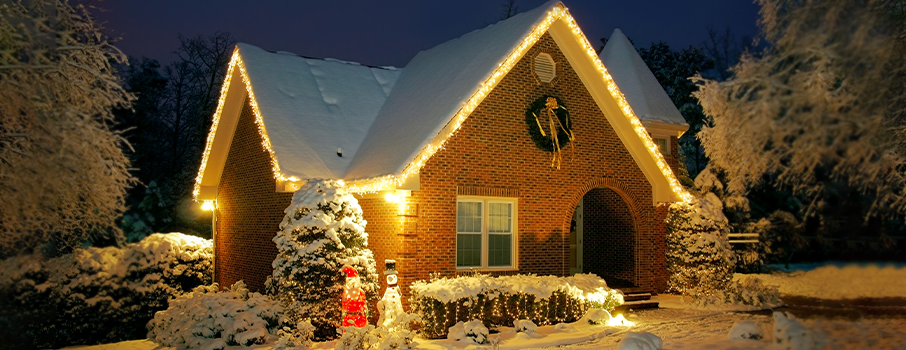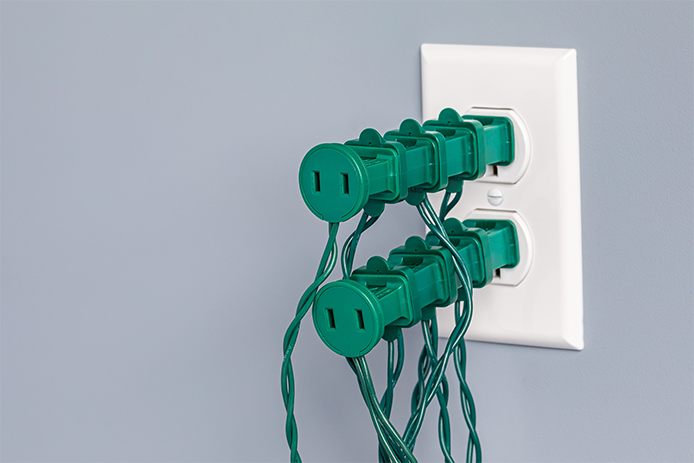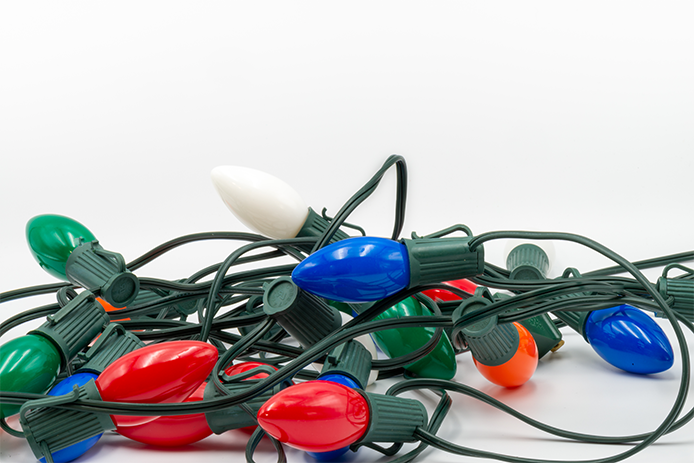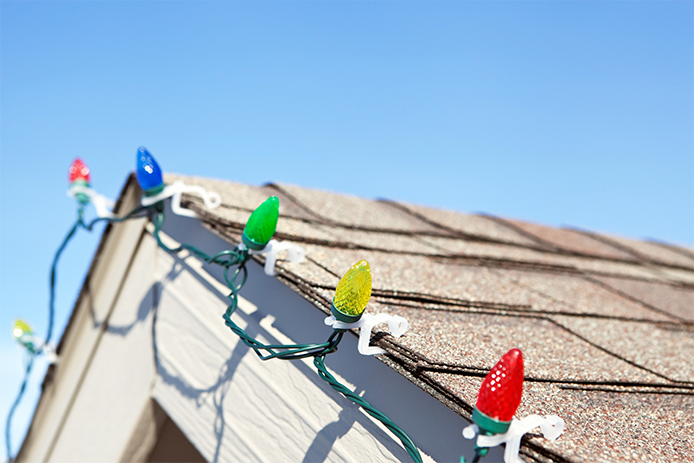
Are you ready to get in the holiday spirit? Before you start throwing up those Christmas lights, it’s important to understand how they work. Have you ever used too many lights and overloaded the circuit? It’s okay, we’ve all been there. Before you start hanging those outdoor Christmas lights up, check out these tips below for proper light usage.
How many Christmas lights can I plug into one outlet?

We know it’s tempting to take all of those outdoor lights, strand them together, and plug them into one long extension cord. While that may seem like the easiest thing to do, it’s important to make sure you don’t plug too much into one outlet. Doing so could overload your circuit or potentially cause a fire. So what’s the magic number? Well, it can depend on a few factors:
- Type of lights: LED lights use less energy and will reduce the chance of overload versus using incandescent Christmas lights.
- Light wattage: Different lights can operate at different levels of wattage. Check your light packaging to see the wattage for your specific strand.
- Circuit amperage: Most household outlets can handle around 120 volts and 15-20 amps. To figure out how many watts of light your outlet can hold, take the amperage of your circuit and multiply it by the voltage.
Using the information above, you can calculate your outlet’s potential wattage. For example, if your outlet can run 120 volts and 15 amps, you can use a max of 1,880 watts of lights (120 volts X 15 amps = 1,880 watts). So if one strand of your lights uses 40 watts, you could use a max of 47 strands on one circuit (1,880 circuit watts / 40 light watts). However, we never recommend loading your circuit to the max. In this case, we would recommend playing it safe at around 80% of your circuit wattage, which would be 1,440 watts or 36 40-watt light strands.
Why do my Christmas lights keep tripping the breaker?

It’s no doubt that it’s frustrating when your breaker keeps tripping over and over again. But why does this happen? There could be a few reasons:
- Overloaded circuit: When you plug too many lights into one circuit, you can overload it. Use the information above to determine how much energy your circuit can handle.
- Bad wiring: Be sure to always check the wiring of your Christmas lights and other holiday decor. Any frays, tears, or shorts in the wiring could trip the breaker.
- Old breaker: This problem is a bit more complex as you can’t simply replace your breaker without re-doing the wiring with the help of an electrician. To avoid tripping an old breaker, try unplugging unused appliances, reducing the number of extension cords you use, upgrading to LED Christmas lights, and using multiple outdoor circuits when possible.
How many amps do Christmas lights use?

Different types of Christmas lights will use a different amount of energy and will even vary by brand and size. As a general rule of thumb, to determine the amps used by your lights, locate the wattage on your package and divide it by 120 volts (for the average household). So if your strand of Christmas lights runs at 40 watts, they would use 0.33 amps (40 watts / 120 volts = 0.33 amps).
If you want to use less energy and worry less about your light wattage and amps, consider solar-powered Christmas lights, or even battery-powered lights.
Kinds of Christmas lights

So you’re starting to browse Christmas lights when you see countless options available. Well, the ones you choose will ultimately depend on your energy requirements and the style you are going for. Here are some of the most popular choices to help you narrow down your decision.
Note: Always use caution when hanging lights outdoors. Click here to learn how to hang outdoor Christmas lights safely.
- C9 Christmas lights (The BIG ones!): These lights are the larger of the two most traditional Christmas lights. C9 Christmas lights have a large bulb size making them ideal for outdoor applications.
- C7 Christmas lights: With a slightly smaller bulb base than C9, C7 Christmas lights come in a variety of colors and are great for various applications.
- Icicle Christmas lights: Available in LED and incandescent, icicle lights are designed to look like frozen icicles and add a layer of fun to your holiday decorations.
- String lights: The most common type of Christmas lights, string lights are great for Christmas trees, indoor decor, and outdoor decor!
- Rope lights: Available in many color options, rope lights are great for outdoor applications such as roofs, decks, and patios.
- Net light sets: Net lights, as the name implies, look like netting and are excellent for applications covering a large area, outdoor bushes, and more.
Christmas Light Clips

Once you’ve picked out the perfect lights, you’re going to want some clips to help hang them. To help you get started, here are a few different types to choose from:
- Clip-on light clips: One of the most versatile options, clip-on light clips are great for both indoor and outdoor use. They eliminate the need to use nails or tape and can be used to secure lights to decks, fences, gutters, railings, and more!
- Suction cup light clips: Great for windows and smooth, flat surfaces, suction cup light clips are easy to remove and reposition. They are also excellent for holiday lights with larger bulbs.
- Adhesive light clips: If you’re looking for an easy damage-free way to hang your lights, adhesive light clips are a perfect choice. Outdoor options are easy-to-use and are built to handle extreme temperatures without fail.
Now that you know how to calculate the amount of wattage your circuit can handle, you’re ready to start hanging Christmas lights safely. So grab a friend and start preparing for the perfect Christmas light show!










